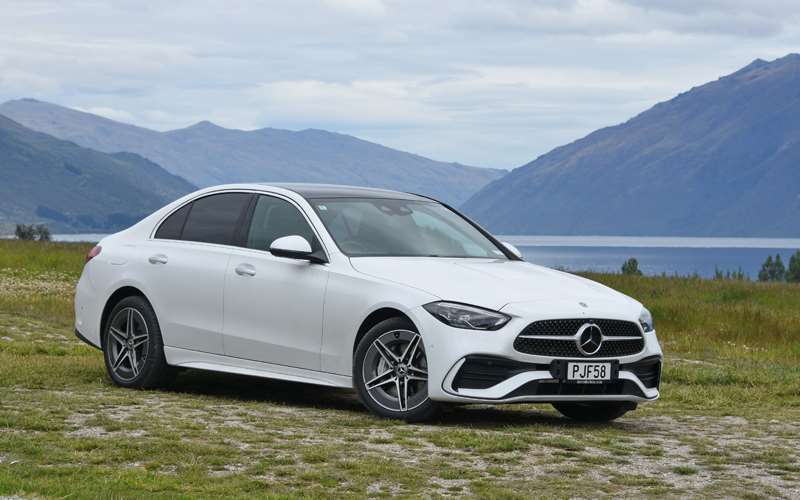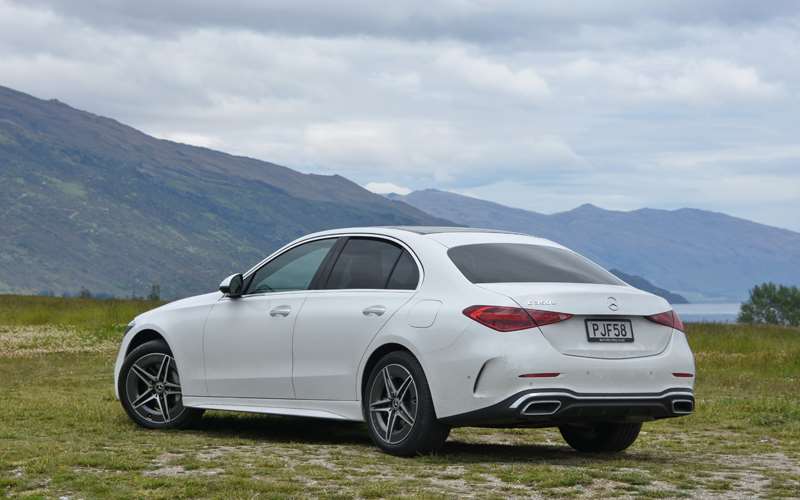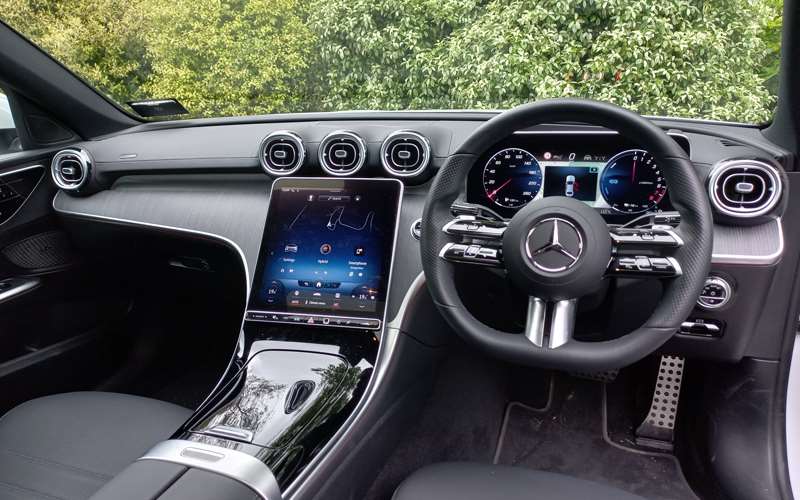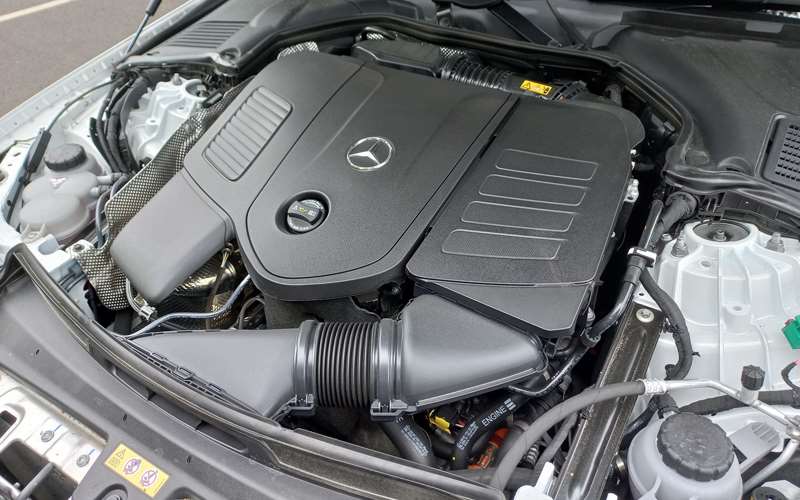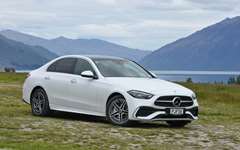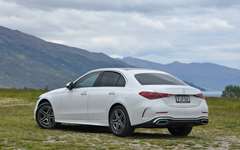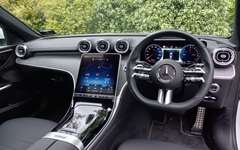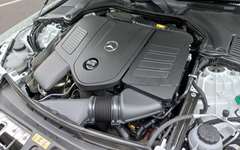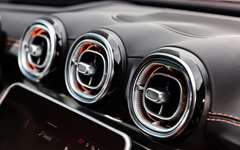A plug-in hybrid is the current flagship of the new Mercedes C-Class range. David Thomson puts it to the test.
What’s new?
When Mercedes launched the latest fifth-generation C-Class saloon here a year ago, it landed as an all-petrol lineup comprising the entry-level 1.5L 150kW/300Nm C200 at $87,800, and the lustier 2.0L 190kW/400Nm C300 at $105,000. Plans had already been set to add a plug-in hybrid to the mix, and that more recent arrival — the $111,200 C350e — is the subject of this test.
The new C-Class range has appeared at a transitional time for Mercedes, as the roll-out of its fully electric EQ sub-brand gathers significant momentum.
Inevitably, Mercedes models that don’t sit under the EQ moniker will diminish in importance over the coming years, but that’s a process that has already been under way for quite some time with the C-Class.
Back in the years before SUV-mania hit the world, the C-Class was Mercedes’ strongest-selling model, both internationally, and here in New Zealand. More recently models like the GLC compact crossover and the larger GLE have been the marque’s top-sellers around the world.
While the C-Class sales star has been waning in relative terms, Mercedes pressed on with a successor to the previous W205 model, which had been in production since 2014. Its replacement, the W206, sits on the latest iteration of the company’s modular rear-drive platform (MRA2), which made its debut on the current S-class luxury saloon, and will also underpin the upcoming next-generation E-Class.
So the latest C-Class is effectively new from the ground up. In addition to its fresh platform and new bodywork, there is an all-new interior, the latest in Mercedes’ safety and driver-assist technologies, and the most recent version of its MUBX infotainment system.
While there was a plug-in hybrid in the previous C-Class line-up, the latest C350e lifts the game appreciably in this regard too.
Most importantly, the C350e packs a 25.4kWh battery pack, providing a step-change in real-world range under battery power alone of around 100km; its predecessor — called the C300e — ran with a 13.5kWh battery, and had around half the battery-only range.
On the C350e the battery powers a 95kW/550Nm electric motor, while the fossil fuel side of its set-up is a detuned 150kW/320Nm version of the same 2.0L engine that powers the pure-petrol C300. When operating together, the petrol and electric motor are regulated to deliver a combined peak output of some 230kW and 550Nm. Power from the hybrid system is delivered to the rear wheels via the 9-speed automatic transmission that features elsewhere in the Mercedes range.
Performance-wise, the C350e delivers similar off-the-mark acceleration to the C300, covering the 0-100kmh sprint in a shade over six seconds, but holds the edge for in-gear responsiveness thanks to the instant torque of its electric motor.
Any real-world economy comparison is highly dependent on the type of driving being undertaken, but the ability of the C350e to complete around 100km under battery power alone gives it a huge advantage; day-in, day-out commuter and short-hop open-road driving should be entirely emissions free.
What comes as standard?
The C350e is well specified, with features including leather upholstery, power-operated front seats, dual-zone climate, auto-dipping lights, and auto wipers all provided. The double-widescreen arrangement that has featured on many Mercedes models in recent years does not appear on the C-Class; instead there is a standalone portrait-format 11.9-inch touchscreen that is cleverly integrated into the front of the centre console, and separate digital instrument cluster.
The MUBX interface covers satellite navigation, a premium sound system, and Mercedes-Me Connectivity Plus. This latter system includes such things as live traffic information, a parked-vehicle locator, and vehicle-tracking and emergency service call functionality. Smartphone integration, and Bluetooth and wired connectivity are provided, though with only a single USB-C plug point up front.
Extra-cost options are plentiful, and the test car included several thousand dollars’ worth, including Opalite White Bright exterior paint (which provides a shimmering semi-metallic finish), and the interior vision package (which includes such items as a panorama sunroof, head-up display and memory and heated front seats).
A comprehensive suite of safety and driver-assist systems are standard across all C-Class variants. These include a raft of warning systems, lane-keeping and active-steering systems, rear-axle steering, and suite of ten airbags.
The adaptive cruise control includes route-based speed adaptation (more later) and auto-stop functionality from speeds of up to 100kmh.
What’s it look like?
If you get the initial impression that this latest C-Class has a squatter, more purposeful and planted stance than its predecessor, you’d be right; dimensionally it is both a little wider and a little lower.
The more aggressive look is emphasised by a stronger more heavily sculpted nose, and by firmer, less fussy detailing along the flanks. Several key design cues carry over from the much larger, flagship S-Class saloon, and will also feature on the upcoming new iteration of the intermediate-sized E-Class saloon.
LED lights are, of course, standard all round. Multi-spoke 19-inch AMG alloys are standard fit on the C300, but the C350e takes the same five-spoke 18-inch alloys as the C200. That’s a win in my view, because the multi-spoke alloys look quite fussy and are shod with slightly lower-profile tyres that will impact a little on ride quality.
The contrast between the Opalite White Bright paint finish, the tinted window glass and black roof also worked a treat on the test car.
What’s it like inside?
It’s reasonable to expect the cabin of a premium Mercedes-Benz to look and feel special, and that is the case with the C350e.
Attention to detail was evident in the test car’s contrast surfacing, with soft uppers, metallic highlighting, and muted woodgrain inserts. The seats, meantime, featured a mix of black and charcoal-grey panelling. My one criticism of material choice is the extensive use of a gloss-black finish towards the front of the centre console, as it is prone to smudging, and probably scratch damage too.
Defining features of the dash are the large centre screen, and turbine-like air vents (a trio in the middle and one either side) which have morphed from a round to oval shape with this new generation C-Class.
The latest digital interfaces enable a further move away from conventional switches and buttons. While this helps de-clutter the front of the cabin, I am not a particular fan of the haptic and pressure pad controls that have replaced key switches. Those for the seat control were a particular irritant in testing; they felt flimsy compared to the previous mechanical switches, and fine adjustment was also more challenging.
The rear seats allow for three occupants, with a fold-down armrest available when the middle is free. Especially for two passengers, rear room is good by class standards.
Boot space drops from the 455L of the petrol-only C-Class to 315L on the hybrid. That’s an important consideration to bear in mind for those people used to carrying a reasonable amount of luggage, noting also that some boot space is already taken up by the bag containing the plug-in charge cables.
What’s it like to drive?
These days the week-in, week-out diet of a motoring writer largely comprises SUV and high-riding SUVs, front or all-wheel drive. A low-slung, rear-drive saloon such as the C350e, is therefore a rare treat.
Several different drive modes are available, ranging from battery-only through to sport mode, that unleashes both petrol and electric motors for maximum performance.
The default mode is E, or electric. So long as there is battery charge remaining, this mode will run the car via the electric motor alone, unless the accelerator is floored, which triggers the petrol engine to join in.
It’s a mode that makes perfect sense for around town motoring, and on shorter commuting highway hops too, as it minimises petrol use, and maximises the smoothness and silence of pure electric power delivery.
Hybrid (or H) mode is more of a mix-and-match of pure electric and combined petrol-electric propulsion. Having the petrol engine — which is not especially silent nor characterful — cut in and out impacts adversely on refinement, meaning this is not ideal for work around town. However, it makes sense on highway hauls more than the vehicle’s electric-only range.
Sport mode takes things one step further with the buzz of the petrol engine a constant companion, and while this maximises performance, acceleration is more than adequate in hybrid mode.
In modes other than sport, different levels of regenerative braking can be selected using the paddle-shift steering controls, and there is plenty of satisfaction to be gained by engaging in one-pedal driving. To do so — using the regen braking rather than brake pedal to slow the car — requires a smooth and considered driving approach, which in turn suits the relaxed character of the C350e to a tee.
Handling is sweet, with the car’s rear-drive balance a rare delight in these days of mainly front and four-wheel drive. The steering is decently weighted, grip is strong and if one might wish for a little more brake pedal feel, then it’s best to remember that the skill with this car is to avoid using that pedal at all.
Ride quality is exemplary and wind roar is well contained, but coarse chip rumble is a negative factor on longer open-road trips.
After a couple of days of zero-emissions motoring, I headed from Dunedin to Te Anau and back. Fuel consumption during this open-road portion of the test was around the 7.0L/100km mark, while the overall return for my time with the car was 5.2L/100km. Most owners will likely spend more time than I did on short-hop pure-electric runs, and so should manage better long-run economy.
Simple home charging using a regular three-pin plug was the obvious option for keeping the previous-generation C-Class hybrid juiced up. It’s still possible with the C350h, though with the larger 25.4kWh battery, installing a higher capacity wall box makes sense so the vehicle can fully charge from near empty in a couple of hours.
Hooking up to a commercial charger is possible too, though charge speed is limited to 11kW unless you invest in the Charging Package PLUS, which adds direct-current (DC) charging of up to 55kW and increases the maximum possible rate of charge for AC charging to 22kW.
Verdict
Combining the best of old-school rear-drive saloon virtues with a contemporary plug-in hybrid system and the latest in Mercedes-Benz style and hi-tech, the 350e is an impressive standard bearer for the latest C-Class range.
